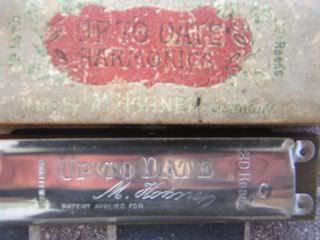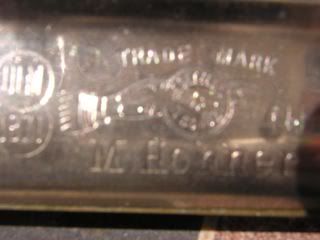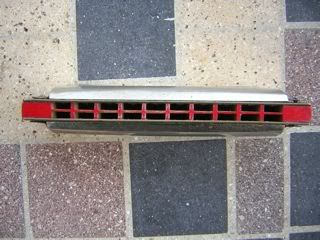AV8R
147 posts
Jun 11, 2011
3:11 PM

|
I picked this one up in Kentucky-it has many of the "prewar" clues- Mouse ears, the Star of David, and also the Philad mark, which I believe is another vintage indicator.----The box is lined with red silk and velour and has a cool art deco look. I saw a similar box on Ebay, the seller said it was circa 1915 but that could be BS.
If anyone can provide any additional insight regarding these harps I would appreciate it. Here are some pics (I hope). Thanks.----------

]


 Last Edited by on Jun 11, 2011 3:23 PM
Last Edited by on Jun 11, 2011 3:23 PM
|
arzajac
535 posts
Jun 11, 2011
3:20 PM

|
http://www.patmissin.com/ffaq/q38.html
"Hohner produced more than a dozen different models bearing the name Up To Date,...
... It is perhaps possible that the 1896 model had different names for different markets, as another Hohner catalog from the same year shows the 1896 model with the name Marine Band and the familar picture of Matthias Hohner on the cover (also with the words PATENT APPLIED FOR, even though the accompanying caption clearly states Patented August 24th 1897). "
----------

Last Edited by on Jun 11, 2011 3:20 PM
|
AV8R
148 posts
Jun 11, 2011
7:29 PM

|
Thanks Arzajac-I have found that dating a harmonica as "pre-war" is fairly straightforward, but trying to narrow it down further is difficult.
----------

|
KingoBad
764 posts
Jun 11, 2011
9:25 PM

|
It is an Octave harp.
You probably already knew that though...
----------
Danny
Last Edited by on Jun 11, 2011 9:27 PM
|
AV8R
150 posts
Jun 12, 2011
6:28 AM

|
@ Kingo No I didn't, thanks. Dumb question -What's the purpose of an octave harp?
----------

|
JackStephen
2 posts
Nov 04, 2011
11:56 AM

|
No, it's not an Octave Harp. It has a segmented comb only to give it the look of the more expensive harmonicas of the time. Let's call it "discrete comb" because it works the same as the Winslow's invention, isolating every reed.
I own an identical harp. Contacted Pat Missin asking a few questions and he agrees that the harp is circa 1895. It says "patent applied for" because Mr Hohner was waiting for the famous "1896" patent award, that is the reason every Marine Band is called "1896".
Enjoy your harp, you scored a nice one.
|
WinslowYerxa
120 posts
Nov 04, 2011
1:37 PM

|
Hohner produced a few 20-reed non-octave harps with the divided comb. Another one is the "New Best Quality"; I have one that seems to date to around 1925, with covers similar to the original Old Standby.
I've seen catalog page reproductions from this period that give the impression that octave harps were marketed as superior - more volume of tone, twice the reeds, etc. To take advantage of this, it appears that Hohner then produced non-octave harmonicas that had the horizontal hole divider like the octave harps did, solely to sell 20-reed harmonicas by association with the more prestigious 40-reed (octave) models. This appears to one of those
|
WinslowYerxa
121 posts
Nov 04, 2011
1:40 PM

|
By the way, the shallow chambers created by the horizontal divider make these harps respond poorly to any but the softest air flow. That's one thing I addressed in designing the Discrete Comb, by making the chambers bigger internally, and slightly taller.
Last Edited by on Nov 04, 2011 1:40 PM
|
florida-trader
68 posts
Nov 05, 2011
7:19 PM

|
I too have one of these harps. When I took it apart it was apparent to me that it had never been played. It had no gunk in the comb or any signs that there had ever even been moisture in there. The reed plate were equally clean. And the box is immaculate.
Jack is absolutely correct that it is not an octave. It is a diatonic with a discrete comb. The one that I have sounds fantastic but I plan to build a comb for it so I can see what it sounds like with a modern day diatonic set-up.
----------
  ">
Last Edited by on Nov 07, 2011 12:30 PM ">
Last Edited by on Nov 07, 2011 12:30 PM
|
AV8R
160 posts
Nov 06, 2011
8:28 AM

|
Thanks guys for the additional information regarding this harmonica.
It does say "Twenty Reeds" on the top coverplate, i suppose so as not to mislead people into thinking they were buying a chromatic.
----------

|
arzajac
745 posts
Feb 11, 2012
6:54 PM

|
A fellow asked me to restore one. Had I realised that it was pre-1900, I would have thought twice before opening it.
Since re-reading this thread, I took a closer look at the reedplates. The draw reedplate is identical to the blow plate. This is different than current harmonicas where the draw reedplate rivets are not lined up with the back of the plate - the reed tips line up at the front - not so on this harp. So the reed tips are farther away from your mouth the higher you go on the harp.
Another thing is the the reed curves. I have a harp from the 20s and the curves are stellar! The curves on this are as bad as a toy harp. I browsed around the net and found a few of these same harps. They mostly seem to be in great condition - hardly played but kept.
My experience with vintage harps are that the best ones are the ones that are worn out. Someone played them until they wore out and still kept them. Years later they end up in an estate sale...
So why did people keep this harp? I am assuming that it plays like crap by the looks of it.
----------

|
florida-trader
90 posts
Feb 11, 2012
7:11 PM

|
The Up to Date that I have plays very well. The discrete comb makes it harder to get the upper and lower reeds to react to one another (perhaps it is mechanically impossible - but I'm no engineer). I haven't gotten around to it yet but I have a few other harps with identical combs. I would like to cut the horizontal partition out of one so I would have a comb that is not discrete and try these reed plates out on it. I bet it would play awesomely.
----------
  "> ">
|